Customer Referral Strategy Guide: How to Grow Your Shopify Store in 2026
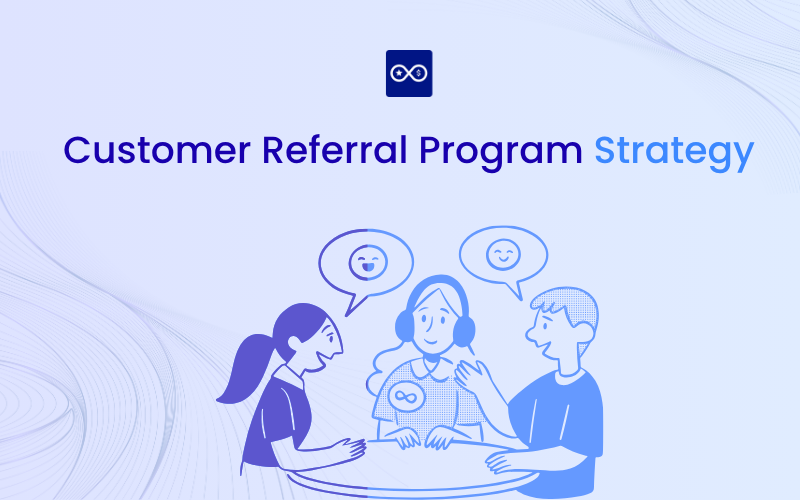
Word-of-mouth recommendations drive more sales than any advertisement you could run, yet most Shopify stores leave this powerful channel completely untapped. Your satisfied customers already want to tell their friends about products they love, they just need a reason and an easy way to do it.
This guide walks you through building a customer referral strategy that turns casual buyers into active promoters, from choosing the right reward structure to measuring ROI and preventing fraud.
What Is a Shopify Referral Program?
A Shopify referral program is a system where your existing customers recommend your products to friends and family in exchange for rewards like discounts, store credit, or free products. Since Shopify doesn’t include built-in referral features, you’ll install a third-party app from the Shopify App Store that handles the tracking, reward distribution, and link generation automatically. The app creates unique referral links for each customer, monitors when someone makes a purchase using that link, and distributes rewards to both the person who shared and the new customer who bought.
Here’s how the basic flow works: a customer joins your program and receives a trackable link or code they can share through email, text messages, or social media. When someone uses their link to make a qualifying purchase, the system records the conversion and issues the rewards you’ve set up. Both parties get something: the referrer earns credit toward future purchases while their friend gets a discount on their first order.
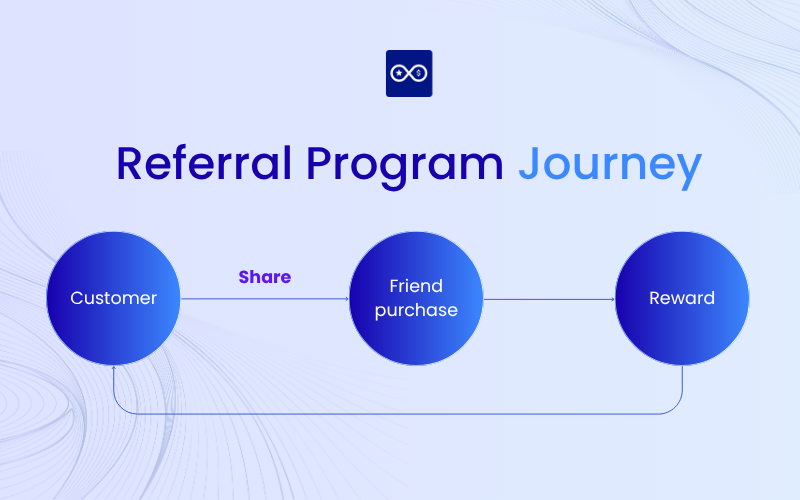
Why Referral Marketing Drives Profitable Growth?
Referral marketing turns the trust between friends into a customer acquisition channel. People are far more likely to try a product when someone they know vouches for it, which means referred customers arrive ready to buy rather than skeptical and browsing.
Drive Higher Conversion Rates
Referred customers convert at significantly higher rates than those who click on ads. When a friend recommends your store, they’ve already done the convincing work—the new customer shows up with built-in trust. This social proof eliminates much of the hesitation that typically slows down buying decisions.
Lower Customer Acquisition Costs
Traditional advertising channels like Facebook Ads often cost $20-50+ to acquire a single customer. With referral programs, you only pay the reward value you’ve set, and only when a sale actually happens. Your existing customers handle the marketing work voluntarily, and the cost stays predictable and tied directly to results.
Increase Customer Lifetime Value
Referred customers tend to stick around longer and spend more over time compared to customers acquired through ads. They’re more likely to make repeat purchases and become advocates themselves, creating a compounding effect. This happens because they enter through a trusted relationship rather than a transactional advertisement.
How the Referral Process Works From Click to Purchase
The referral journey follows a clear path from the moment your customer decides to share to the point where rewards land in both accounts. Understanding each stage helps you spot where friction might prevent successful referrals.
Advocate Invitation and Link Creation
After a customer makes a purchase, your referral app generates a unique tracking link or code assigned specifically to them. This link contains parameters that identify which customer made the referral, making sure credit goes to the right person. Most apps let you automatically enroll customers after their first purchase, capturing them when they’re most excited about your product.

Share Channels Email SMS Social Media
Customers share their referral links through whatever channels feel natural—email, text messages, Instagram stories, Facebook posts, or even QR codes they show in person. Email tends to convert best because it’s personal and direct, while social media generates broader reach but lower conversion rates. Your referral app typically provides pre-written messages and social sharing buttons to make the process frictionless.

Friend Redemption and Purchase
When someone clicks a referral link, the system places a tracking cookie in their browser and often applies a discount code automatically at checkout. If they make a qualifying purchase within the attribution window—usually 30 to 90 days—the system records this as a successful referral. The tracking technology makes sure credit goes to the right advocate even if the new customer doesn’t buy immediately.
Reward Fulfilment and Tracking
Once the purchase clears and any return windows pass, the referral app automatically distributes rewards to both the referring customer and the new customer according to your program rules. The advocate might receive store credit added to their account, while the new customer gets their discount applied at checkout. Modern platforms include fraud detection to prevent self-referrals and fake accounts.
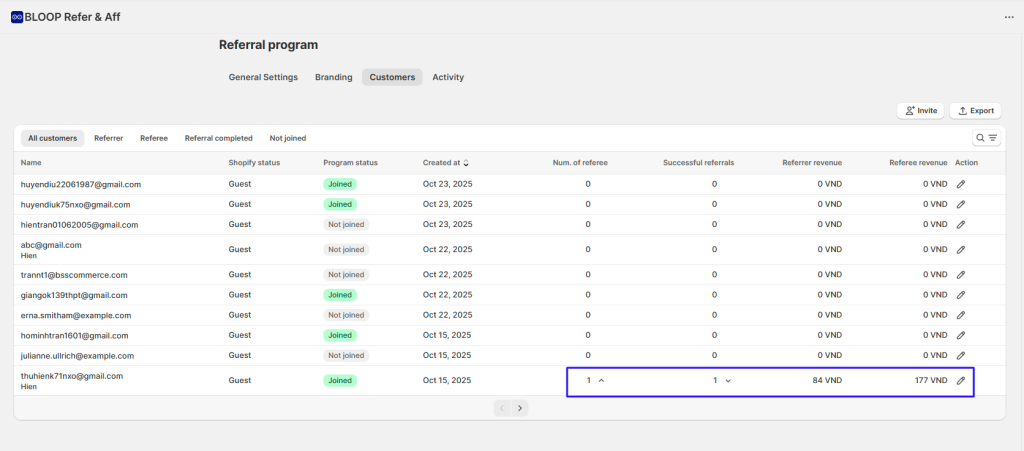
Referral Program Types and Reward Structures
Different reward structures appeal to different customer segments and business models. Your choice affects both participation rates and program profitability.
One-Sided Rewards
One-sided programs reward only the referring customer, typically with store credit or a discount on their next purchase. This structure works well when your products have strong appeal and don’t require additional incentive for new customers to try them. It’s simpler to communicate and manage, though it may generate fewer conversions since the friend receives no immediate benefit.
Two-Sided Rewards
Two-sided programs offer incentives to both parties—for example, “Give $10, Get $10” or “You both get 20% off.” This structure creates mutual benefit that motivates both sharing and purchasing. The additional cost per acquisition is often worth it because of the increased volume of successful referrals.

Tiered Milestone Rewards
Tiered programs increase rewards as advocates hit referral milestones—perhaps $10 credit for the first referral, $15 for the third, and $25 for the fifth. This approach encourages your best advocates to keep sharing rather than stopping after one or two referrals. Some stores add exclusive perks like early product access or VIP status for top performers.

Cash Versus Store Credit
Store credit keeps revenue within your business and encourages repeat purchases, making it the most profitable option for most merchants. However, cash rewards through PayPal or bank transfer may be more appealing to advocates who want immediate, flexible value. Consider your margins and customer preferences when deciding between the two.
Step-By-Step Setup Guide for Your First 30 Days
Launching a referral program doesn’t require months of preparation. Most Shopify merchants can go from idea to live program within a week.
1. Define Goal and Key Metrics
Start by deciding what success looks like—are you aiming for 100 new customers in 90 days, a specific percentage of revenue from referrals, or improved customer lifetime value? Choose two to three metrics to track, such as referral conversion rate, referral revenue, and cost per acquisition through referrals versus other channels.
2. Choose Incentive and Rule Set
Determine your reward amounts by calculating what you can afford while staying profitable. A common starting point is 10-20% of your average order value for each party, adjusted based on your margins. Establish clear rules about minimum purchase amounts, exclusions, and whether rewards apply to sale items.
3. Install and Configure Referral App
Browse the Shopify App Store for referral apps that fit your budget and feature requirements. Bloop offers both referral and affiliate functionality in one platform, letting you manage customer advocates and content creator partnerships from a single dashboard. After installation, connect the app to your Shopify store and configure basic settings like reward amounts and program terms.
4. Design On-Brand Widgets and Emails
Customize your referral program’s visual elements to match your store’s branding by updating colors, fonts, and messaging in the referral widget, landing page, and automated emails. The referral experience ought to feel like a natural extension of your brand, not a generic third-party tool.
5. Launch Softly to VIP Customers
Rather than announcing to your entire email list, start by inviting your 50-100 most loyal customers—those with multiple purchases, high order values, or positive review history. This soft launch lets you gather feedback, identify technical issues, and refine your messaging before scaling.
6. Measure Results and Optimise
After two weeks, review your metrics and identify what’s working. Are people signing up but not sharing? Your incentive might not be compelling enough. Are people sharing but friends aren’t converting? Your offer to new customers might be the issue. Make one change at a time so you can attribute improvements to specific actions.
How to Promote Your Program and Motivate Shares
Even generous referral programs won’t succeed if customers don’t know they exist. Strategic promotion across multiple touchpoints keeps your program visible.
Email and Post-Purchase Flows
Send a dedicated email to your customer list announcing the program launch, explaining how it works, and highlighting the rewards. After launch, add referral invitations to your post-purchase email sequence. The order confirmation email is particularly effective since customers are excited about their purchase.
Consider these email timing strategies:
- Immediately after first purchase: Capture peak satisfaction and excitement
- After product delivery: Once they’ve experienced the product quality
- Following positive support interactions: When they’ve just had a great experience
- On purchase anniversaries: Remind long-term customers they can earn rewards
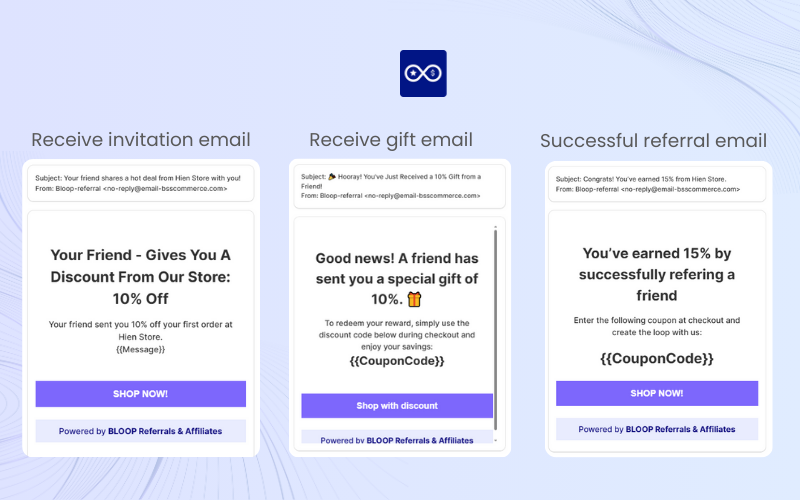
SMS and Push Notifications
Text messages achieve open rates above 90%, making them powerful for time-sensitive referral promotions. Send SMS invitations to customers who’ve opted in, especially during special bonus periods like “Double rewards this weekend only.”
Social Proof Widgets and Pop-Ups
Add a permanent referral program link to your site’s main navigation and footer so it’s always accessible. Display the program prominently in customer account dashboards where people naturally look after making purchases. Exit-intent pop-ups can catch visitors before they leave, offering them a discount if they refer a friend.
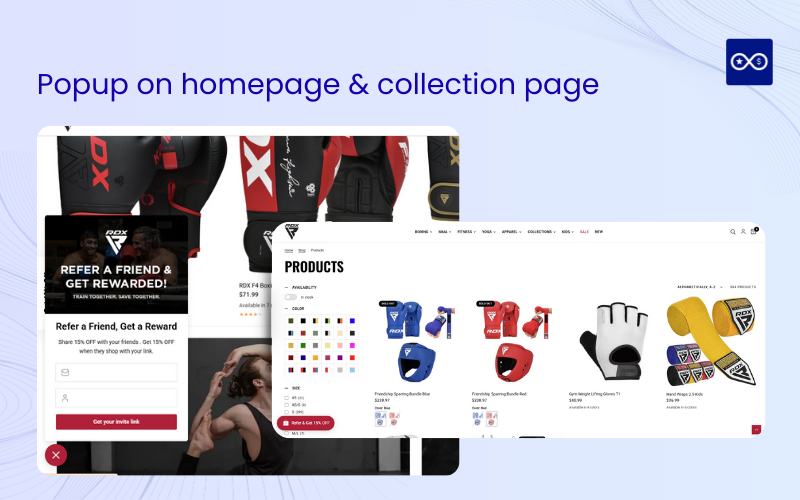
Influencer and UGC Collaboration
Your micro-influencers and content creators can function as super-advocates who reach audiences you can’t access directly. If you’re running an affiliate program alongside referrals, invite your best-performing affiliates to also participate in the referral program for their personal networks.
Advanced Optimization Tips for Scaling Referrals
Once your program is running smoothly, advanced tactics can multiply your results.
Segment High-Value Advocates
Analyze your referral data to identify customers who’ve made three or more successful referrals or generated significant revenue. Create a VIP tier with exclusive benefits like higher reward percentages, early access to new products, or direct communication with your founder.
A/B Test Incentives and Copy
Test different reward amounts to find the sweet spot between attractive incentives and profitability. You might discover that $15 credit performs just as well as $20, or that “20% off” converts better than “$10 off” even when the dollar value is similar.
Automate Bonus Campaigns
Set up seasonal promotions where referral rewards temporarily increase—”Refer a friend this week and you both get $20 instead of $10.” Limited-time bonuses create urgency and can reactivate advocates who haven’t shared recently.
Localize for Multi-Currency Stores
If you sell internationally, adapt your referral rewards for different markets rather than using a one-size-fits-all approach. A $10 reward might be generous in some countries but insignificant in others.
Common Challenges and How to Prevent Fraud
Referral programs attract both genuine advocates and opportunists looking to exploit the system. Building in protections from the start prevents headaches and preserves program profitability.
Coupon Abuse Detection
Self-referrals—where customers create fake accounts to refer themselves—are the most common form of fraud. Quality referral apps detect suspicious patterns like multiple accounts from the same IP address, similar email addresses, or identical shipping addresses.
Duplicate Account Screening
Monitor for customers creating multiple accounts to claim new customer rewards repeatedly. Device fingerprinting technology can identify when the same device is being used across multiple accounts, even if the email addresses differ.
Return and Chargeback Handling
Establish clear policies for what happens when a referred purchase gets returned or charged back. Most programs claw back rewards if the purchase is refunded within 30-60 days, which protects you from reward fraud while being fair to legitimate returns.
Choosing the Best Shopify Referral App or Platform
The right referral software makes the difference between a program that runs smoothly and one that creates constant headaches.
Feature Checklist to Compare
| Feature | Why It Matters |
| Automatic enrollment | Reduces friction by adding customers to your program without manual action |
| Fraud prevention | Protects profitability by detecting self-referrals and duplicate accounts |
| Customizable branding | Makes the referral experience match your store’s look and feel |
| Multi-reward types | Lets you offer store credit, discounts, free products, or cash rewards |
| Analytics dashboard | Provides insights into program performance and top advocates |
| Email automation | Sends referral invitations and reminders without manual work |
| Mobile optimization | Creates smooth sharing experience on smartphones where most sharing happens |
Referral and Affiliate Hybrid Options
Some platforms combine referral programs for customers with affiliate programs for content creators and influencers. This unified approach lets you manage both word-of-mouth marketing from customers and partnership marketing from influencers in one dashboard.
Pricing Models and ROI
Referral apps typically charge monthly subscriptions ranging from $20 to $200+, commission-based fees as a percentage of referral sales, or a combination. Calculate your expected referral volume to determine which pricing model costs less—if you expect high volume, flat monthly fees often work out cheaper than per-transaction pricing.
Affiliate vs Referral vs Loyalty: Which Fits Your Store
These three marketing strategies often get confused, but they serve different purposes and work with different advocate types.
Key Differences in Tracking and Incentives
- Referral programs: Existing customers recommend your products to friends and family in exchange for rewards. Both the referrer and the new customer typically receive benefits. The relationship is personal and based on genuine product satisfaction.
- Affiliate marketing: Content creators, bloggers, and influencers promote your products to their audiences in exchange for commissions on sales. The relationship is more professional and promotional, with affiliates often creating content like reviews or tutorials.
- Loyalty programs: Existing customers earn points or rewards for making repeat purchases, leaving reviews, or engaging with your brand. The focus is on retaining current customers rather than acquiring new ones.
>> Explore: Referral Program vs Affiliate Program: 10+ Differences and Which is good for your Shopify store?
When to Combine Programs
Running referral and loyalty programs together creates a comprehensive customer engagement strategy: loyalty rewards encourage repeat purchases while referrals drive new customer acquisition. Adding affiliate marketing on top lets you tap into influencer audiences beyond your existing customer base.
The Payoff: Metrics to Track and Benchmarks to Beat
Measuring your referral program’s performance tells you whether it’s worth the investment and where to focus optimization efforts.
Share Rate and Invite-To-Purchase Conversion
Share rate measures what percentage of program members actually share their referral links—a healthy program sees 10-30% of enrolled customers sharing at least once. Invite-to-purchase conversion tracks how many people who click referral links end up buying, with 5-15% being typical for most industries.
Referral Revenue and CAC Comparison
Calculate total revenue generated through referral purchases and divide by your total reward costs to determine ROI. Compare your referral customer acquisition cost to other channels like Facebook Ads or Google Shopping, referral CAC tends to run 30-50% lower than paid advertising.
Customer Lifetime Value Uplift
Track whether referred customers have higher lifetime value than customers acquired through other channels. Pull cohort reports that compare six-month or twelve-month purchase behavior between referred and non-referred customers.
Turn Customers Into Promoters With Bloop
Bloop simplifies referral program management for Shopify merchants by combining customer referrals and affiliate partnerships in one intuitive platform. You can launch your program in minutes without technical expertise, customize rewards and branding to match your store, and track performance through a unified dashboard.
The platform includes built-in fraud prevention to protect your program from abuse, automated reward distribution so you never manually process payouts, and seamless Shopify integration that requires no coding. Get started free and launch your referral program today.
Frequently Asked Questions About Shopify Referral Programs
How do I set referral commission rates?
Most Shopify stores offer rewards between 10-20% of average order value, balancing customer motivation with profit margins. Start with $10-15 store credit or 15% discount codes, then adjust based on your specific margins.
What is a good referral conversion rate?
Successful referral programs typically see 5-15% of referred friends complete purchases, though this varies by industry, product price point, and incentive structure.
Can I run a referral program on Shopify Plus?
Shopify Plus stores can use any referral app available in the Shopify App Store. The core referral mechanics work identically across all Shopify plan levels.
How do I offer multi-currency rewards?
Choose referral platforms that support automatic currency conversion and display rewards in each customer’s local currency based on their location or selected currency.
Do referrals violate Shopify terms of service?
Referral programs comply with Shopify policies when they follow platform guidelines and avoid prohibited practices like incentivizing fake reviews or spamming. Legitimate referral programs that reward genuine recommendations are fully supported by Shopify.